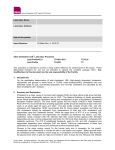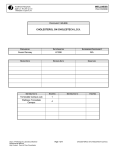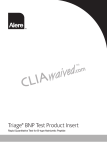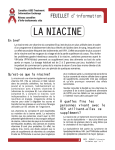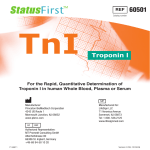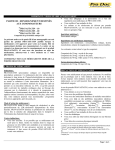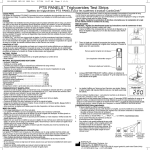Download ALT•AST (GPT•GOT)
Transcript
402_12780.qxd 8/3/04 6:02 PM Page 1 therapy. It is suggested that patients undergoing lipid-lowering drug therapy should be tested for ALT and AST before (baseline) and shortly after initiation of therapy and then periodically thereafter to determine the ALT and AST levels. Alanine aminotransferase and aspartic acid aminotransferase can be measured from a single drop of blood using the Cholestech LDX System’s rapid, accurate technology. An AST/ALT ratio is calculated using the measured values. ALT•AST (GPT•GOT) REF 12-788 CLIA-WAIVED —These tests are waived under CLIA ’88 regulations. If a laboratory modifies the test system instructions, then the test is considered highly complex and subject to all CLIA requirements. For professional in vitro diagnostic use. Cholestech LDX is a registered trademark of Cholestech Corporation. MiniPet is a trademark of TriContinent Scientific, Inc. © 2004 Cholestech Corporation. 402 12780 REV A One or more of the following patents may apply: U.S. Patents 4,477,575, 4,816,224 and 5,110,724. Running a Test Cassettes must be stored in the sealed foil pouches. 1. 2. Cassettes may be used until the date printed on the pouch when stored in a refrigerator (36 – 46ºF / 2– 8ºC). Or the cassettes may be stored for up to 30 days at room temperature (less than 86°F / 30°C). • Alanine Aminotransferase (Glutamate Pyruvate Transaminase) and Aspartate Aminotransferase (Glutamate Oxaloacetate Transaminase) Test Cassette 402 12780 Cassette Storage and Stability 3347 Investment Blvd. Hayward, CA 94545 U.S.A. Tel 800 733.0404 Fax 510 732.7227 www.cholestech.com Authorized Representative AR-MED Ltd Runnymede Malthouse Egham TW20 9BD United Kingdom Refer to the CD in the analyzer package for instructions in English. The instructions are available from your local distributor. Le CD contenu dans l'emballage de l'analyseur inclut les directives d'utilisation en français. Le mode d'emploi est disponible auprès du distributeur local. SUMMARY AND EXPLANATION The Cholestech LDX System combines enzymatic methodology and solid-phase technology to measure ALT and AST. Samples used for testing can be whole blood from a fingerstick (collected in a heparin-coated capillary tube) or venous whole blood. The sample is applied to a Cholestech LDX ALT/AST cassette. The cassette is then placed into the Cholestech LDX Analyzer where a unique system on the cassette separates the plasma from the blood cells. The plasma flows to both sides of the cassette and is transferred to the ALT and AST reaction pads. The Cholestech LDX Analyzer measures alanine aminotransferase by an enzymatic method based on the method formulation of Katsuyama et al.1,2 Alanine aminotransferase catalyzes the transfer of amino groups from L-alanine to alphaketoglutarate, producing pyruvate and glutamate. Pyruvate oxidase, in the presence of oxygen, oxidizes the pyruvate to acetylphosphate and hydrogen peroxide. In a reaction catalyzed by horseradish peroxidase, the peroxide reacts with an indicator dye to form a blue color at a rate proportional to the ALT concentration of the sample. The resultant color in the reaction is measured by reflectance photometry. • • • Please Note: The Cholestech LDX System is CLIA-waived for fingerstick or venous whole blood unprocessed samples only. If you run serum or plasma on the Cholestech LDX, you will be classified as moderately complex and will have to comply with the regulations for moderate complexity. See the Cholestech LDX System User Manual for a summary of these regulations. Acetylphosphate + CO2 + H2O2 • Colored Blue Dye + H2O • • Peroxidase Indicator + H2O2 The Cholestech LDX Analyzer measures aspartate aminotransferase by an enzymatic method based on the method formulation of Katsuyama et al.1,2 Aspartic acid aminotransferase catalyzes the transfer of amino groups from L-Aspartic acid to alpha-Ketoglutarate producing oxaloacetate and glutamate. Oxaloacetate Decarboxylase converts the Oxaloacetate to Pyruvate by the removal of CO2. Pyruvate oxidase, in the presence of oxygen, oxidizes the pyruvate to acetylphosphate and hydrogen peroxide. In a reaction catalyzed by horseradish peroxidase, the peroxide reacts with an indicator dye to form a blue color at a rate proportional to the AST concentration of the sample. The resultant color in the reaction is measured by reflectance photometry. L-Aspartic acid + alpha-Ketoglutarate Oxaloacetate Decarboxylase Fare riferimento al CD nella confezione dell'analizzatore per istruzioni in italiano. Le istruzioni sono disponibili presso il distributore di zona. Pyruvate + Phosphate + O2 + H2O • Collect blood into a green-top tube (heparin anticoagulant). Use a MiniPet™ Pipette and tip to place blood into the cassette. Whole blood should be used within 30 minutes. Samples should be at room temperature for testing. Mix all samples by inverting gently 7– 8 times before testing. Oxaloacetate+ Glutamate Pyruvate + CO2 PRECAUTION: All blood samples and containers, capillary tubes and materials that have come in contact with blood should be handled as if capable of transmitting infectious disease and discarded into a biohazard waste container after use. Pyruvate Oxidase Acetylphosphate + CO2 + H2O2 Peroxidase Calibration No calibration is done by the user. Test information is on the brown stripe of the cassette. The brown stripe is read by the Cholestech LDX each time a cassette is run. Indicator + H2O2 Consulte o CD no pacote do analisador para instruções em Português. As instruções estão disponíveis junto do seu distribuidor local. A brown magnetic stripe on each cassette contains the calibration information required for the Cholestech LDX Analyzer to convert the reflectance reading to the ALT and AST concentration in U/L, 37°C, 99°F for whole blood. The Lot number and Expiration date are also contained on the stripe. An optics check should be run on the Analyzer each day that patient samples are tested. See the Cholestech LDX System User Manual for instructions. ALANINE AMINOTRANSFERASE AND ASPARTATE AMINOTRANSFERASE CASSETTE Materials Provided: Colored Blue Dye + H2O Test Cassettes Each ALT•AST Cassette contains: INTENDED USE An in vitro diagnostic for the quantitative determination of alanine aminotransferase (ALT) and aspartate aminotransferase (AST) in whole blood. INTRODUCTION Alanine aminotransferase is an enzyme that catalyzes the conversion of alanine to pyruvate. Aspartic acid aminotransferase is an enzyme that catalyzes the conversion of aspartic acid to oxaloacetate. Both are found in cardiac and skeletal muscle, the liver, and other tissues. ALT is most prevalent in the liver. ALT and AST levels are a reflection of alterations in liver function and therefore are a valuable measurement of damage to the liver. Liver damage may be due to chronic alcohol or drug ingestion, or infection. There are a number of lipid-lowering drugs available to treat hyperlipidemia. A side effect of such therapy can be a persistent increase in serum ALT and/or AST (to more than 3 times the upper limit of normal) in about 1% of patients receiving lipid-lowering L-Alanine, ug L-Aspartic Acid, ug alpha Ketoglutaric Acid, ug Sodium phosphate monobasic, ug Oxaloacetate Decarboxylase, U Pyruvate Oxidase (Aerococcus viridans), U Peroxidase (horseradish), U Ascorbate Oxidase (Cucurbita sp.), U (Indicator) 2-(3,5 di-tert-butyl-4-hydroxyphenyl) 4,5-bis(4-dimethylaminophenyl)imidazole, ug Nonreactive ingredients: Buffers and stabilizers TEST PROCEDURE ALT AST 91.9 6.4 9.6 2.4 3.6 1.7 67.1 6.4 8.1 0.34 2.0 3.0 1.7 6.1 6.1 Additional Materials Required: • Cholestech LDX Analyzer and power supply • Alcohol swabs and gauze for cleaning puncture site • Lancets for capillary blood collection • Cholestech LDX Capillary Tubes (with lithium heparin anticoagulant) • Cholestech LDX Capillary Plungers • Gloves • Biohazard waste containers • Quality control material • MiniPet Pipette and tips or micropipetter that will deliver 35 µL for use with venipuncture samples and quality control material • Vacuum collection tubes, needles and tube holders if sample is to be collected by venipuncture The cassette drawer will open. The screen will read: Load cassette and press RUN 5. Place the sample into the cassette well. Use a Cholestech LDX Capillary Tube for fingerstick samples. Use the MiniPet Pipette for controls or venous blood samples. NOTE: Fingerstick samples must be applied within five (5) minutes or the blood will clot. 6. 7. NOTE: Do not use a tube with any other additives because it may cause poor results. • • • • Handling • • • Follow the instructions that come with your controls. Check the expiration date before use. Do not use if expired. See “Running a Test” for procedure. External Quality Control 4. Venous whole blood: Consulte el CD incluido en el envase del analizador para obtener instrucciones en español. También puede pedir las instrucciones a su distribuidor local. ∞Ó·ÙÚ¤ÍÙ ÛÙÔ CD ÛÙË Û˘Û΢·Û›· ÙÔ˘ ·Ó·Ï˘Ù‹ ÁÈ· Ô‰ËÁ›Â˜ ÛÙ· ∂ÏÏËÓÈο. √È Ô‰ËÁ›Â˜ Â›Ó·È ‰È·ı¤ÛÈ̘ ·fi ÙÔÓ ÙÔÈÎfi ‰È·ÓÔ̤· Û·˜. Selftest OK Sample Volume: 35 µL of whole blood. Collect the sample from a fingerstick into a Cholestech LDX Capillary Tube. (See the Fingerstick Procedure in the Cholestech LDX System User Manual.) Place the blood into the cassette within 5 minutes of collection. Blood from the fingerstick should flow freely. Too much squeezing of the finger may cause poor results. Press RUN. In a few seconds the screen will read: Selftest running. Keep the cassette flat after the sample has been applied. Place the cassette into the drawer of the Analyzer immediately. The black bar must face the Analyzer. The brown stripe must be on the right. Press RUN. The drawer will close. During the test the screen will read: [Test Names] Test Running*** 8. Aspartate Aminotransferase Oxaloacetate Se CD:n i analysatorförpackningen beträffande instruktioner på svenska. Instruktionerna finns att få hos din lokala återförsäljare. A high and a low control for each analyte is preferred. Cholestech recommended controls work well with the Cholestech LDX System. If you use other controls, you will need to set ranges for the Cholestech LDX System. Sample Handling Fingerstick whole blood: Pyruvate Oxidase Anweisungen auf Deutsch befinden sich auf der CD in der Verpackung des Analysegeräts. Die Anleitung ist von Ihrem Händler erhältlich. Der henvises til den vedlagte CD i analysatorpakken for instruktioner på dansk. Instruktionerne fås hos den lokale forhandler. Choice of Materials Pyruvate + Glutamate Pyruvate + Phosphate + O2 + H2O Quality control should be run routinely to show that your system is giving accurate results. We recommend the following quality control procedures for the Cholestech LDX System. 3. Cassettes should sit at room temperature for 10 minutes before opening the pouch. Use the cassette as soon as the pouch is opened. Sample Type QUALITY CONTROL NOTE: Gloves should be worn when working with blood samples. Cassette Handling • Alanine Aminotransferase L-Aspartic acid + alpha-Ketoglutarate Once cassettes have been stored at room temperature, they should not be returned to the refrigerator. Do not use a cassette beyond the printed expiration date. Do not use a cassette that has been stored at room temperature for more than 30 days. Do not reuse cassettes. Let cassette sit at room temperature for 10 minutes. Remove the cassette from its pouch. Hold the cassette by the short side only. Do not touch the black bar or the brown magnetic stripe. Put the cassette on a flat surface. 9. Put everything that touched the blood sample or control in a biohazard waste container. When the test is complete, the Analyzer will beep. The screen will read: [Test Name(s)]=### warnings External controls must also be used to demonstrate that the reagents and the assay procedure perform properly. Liquid Level 1 and Level 2 Controls are available from Cholestech. Controls must be tested: • • • • Good Laboratory Practice principles suggest that external controls must be run whenever the laboratory director has any question about test system integrity or operator technique (e.g., when reagents may have been stored or handled in a way that can degrade their performance or when operators have not performed a particular test in recent weeks). If the controls do not perform as expected, repeat the test or contact Cholestech Technical Service before testing patient samples. The quality control results must be in range before testing patient samples. See the Cholestech LDX System User Manual if they are not. Please call Cholestech Technical Service at 800-733-0404 if you have any questions about quality control. RESULTS ALT and AST test results will show on the screen when the test is complete. Calculated results are shown after the DATA button is pressed. LIMITATIONS • 10. Press DATA to show more results. 11. When the results are outside the measuring range, the screen will read: [Test Name]>400 or [Test Name]<10 • • • • 12. If there is a problem with the test, a message will appear on the screen. See the Troubleshooting section of the Cholestech LDX System User Manual if this happens. 13. When the drawer opens, remove the cassette. Put it in a biohazard waste container. Leave the Analyzer drawer empty when not in use. 14. Record the results. 15. To run another cassette, press RUN. The screen will read: Load cassette and press RUN 16. Repeat the test procedure. 17. Otherwise, after 4 minutes a beep will sound and the screen will read: System timeout RUN to continue If the RUN button is not pushed within 15 seconds, the drawer will close. Then the screen will go blank. With each new shipment of cassettes (even if cassettes are from the same lot previously received). With each new lot of cassettes. As otherwise required by your laboratory’s standard quality control procedures. If you are not running the Cholestech LDX under CLIA-waived status, or if your local or state regulations require more frequent testing of quality control material, then quality control must be performed in compliance with those regulations. The measuring range for ALT is 10 – 400 U/L, 99°F / 37°C. Results outside this range will appear as <10 U/L or >400 U/L. The measuring range for AST is 10 – 400 U/L, 99°F / 37°C. Results outside this range will appear as <10 U/L or >400 U/L. Performance of the Cholestech LDX System has not been tested on samples from newborns or pediatric patients. Hemolysis, breakdown of the red blood cells, should be avoided as this will increase the level of ALT and AST and cause inaccurate results Samples with ALT or AST enzyme activity greater than 1000 U/L may consume the substrate prior to the measurement of enzyme activity and could yield falsely low results. Some substances may cause false results with enzymatic tests. The substances listed below were tested for interference with the ALT/AST test. Less than 10% interference was seen at the levels shown. Substance Concentration (mg/dL) Hemoglobin Bilirubin Ditaurobilirubin Ascorbic Acid Urea Uric Acid Creatinine Glutathione Lactate Fructose Lactose Cysteine 75 5 5 1 500 15 30 1 100 30 100 7 Gemfibrozil (Lopid) Oxytetracycline Probucol (Lorelco) Nicotinic Acid (Niacin) Clofibrate (Atromid) Lovastatin (Mevacor) L-Dopa (Levodopa) Cimetidine (Tagamet) Nitrofurantoin Gentisic Acid Methyl dopa Sulfamethoxyzole 15 4 32.5 10 80 4 0.2 5 1 0.5 0.2 16 402_12780.qxd 8/3/04 Glucose Pyruvic acid Triglycerides • 1200 0.2 450 6:02 PM Page 2 Pravastatin (Pravachol) Simvastin (Zocor) Fluvastatin (Lescol) 0.8 4.0 4.0 Hematocrits between 30% and 50% do not affect results. EXPECTED VALUES Sample Type LDX Venous Whole Blood Serum Fingerstick 10 – 40 U/L3 Aspartate Aminotransferase: Reference Interval, 99°F / 37°C 10 – 30 U/L3 Sample Type LDX Precision Serum A study was conducted according to NCCLS protocol EP5-A, Evaluation of Precision Performance of Clinical Chemistry Devices; Approved Guideline (1998).4 Alanine Aminotransferase: Commercial Control Material Level 1 Commercial Control Material Level 2 Frozen Serum Pool 31 3.2 5.4 58 3.1 4.6 169 3.4 6.5 Whole Blood Within-Run Precision Range of Values 53 52 24 0.916 0.914 0.921 0.3 0.5 4.3 0.975 0.971 0.931 10 – 349 19 – 383 15 – 65 3. No. of Pairs Slope y Intercept Correlation Coefficient Range of Values 109 0.97 1.6 0.983 12 – 396 Venous Whole Blood Fingerstick 46 21 Commercial Control Material Level 1 Commercial Control Material Level 2 Frozen Serum Pool 31 6.1 8.8 106 3.5 4.4 277 3.8 5.2 58 2.8 4.8 Slope Correlation Coefficient Range of Values 1.08 0.86 0.3 4.4 0.998 0.934 13 – 343 13 – 65 ALT measured using the Cholestech LDX cassette was compared with a validated reference method traceable to the IFCC reference method and with a bench-top point-of-care chemistry analyzer. Alanine Aminotransferase Results: X = Reference Method (serum) Y = Cholestech LDX Analyzer ALT Consumer Accuracy Study (trained [x-axis] vs. untrained [y-axis]) n Slope Slope 95% Confidence Interval y Intercept y Intercept 95% Confidence Interval r 60 0.976 0.934 to 1.019 1.0 -1.4 to 3.3 0.996 An “untrained user” study was conducted in which participants were given only the test instructions and asked to perform testing of 3 blinded randomized samples. The samples consisted of serum pools prepared at three levels. The participants were not given any training on the use of the test. A total of 72 participants were enrolled from three sites, representing a diverse demographic (educational, age, gender, etc.) population. The table below presents the summary of the performance: N Mean Venous Whole Blood Serum Fingerstick 53 54 24 Slope 1.001 1.007 1.013 Single use Do not use if package is damaged or open Use by: AST WAIVER DATA ACCURACY (METHOD COMPARISON) No. of Pairs In vitro diagnostic medical device Attention. See instructions for use y Intercept A consumer accuracy study was done with 60 lay (untrained) people who reported no medical or laboratory experience. These people were asked to perform one ALT test each by following the directions in the package insert. The samples used for testing were 60 whole blood samples that were either native samples, or samples spiked with ALT. A total of 3 professional (trained) people also assayed the 60 samples (20 samples per trained person) in order to obtain comparative data between trained and untrained populations. The results were analyzed by Deming regression statistics, as described below. Whole Blood Within-Run Precision Sample Type LDX Expert Panel on Detection, Evaluation, and Treatment of High Cholesterol in Adults. Executive summary of the Third Report of the National Cholesterol Education Program (NCEP) Expert Panel on Detection, Evaluation, and Treatment of High Cholesterol in Adults (Adult Treatment Panel III). JAMA 2001;285:2486-97. Bachorik PS, Ross JW, for the National Cholesterol Education Program Working Group on Lipoprotein Measurement. National Cholesterol Education Program recommendations for measurement of low-density lipoprotein cholesterol: executive summary. Clin Chem 1995;41:1414-20. Tietz NW, ed. Fundamentals of Clinical Chemistry. Philadelphia, Pa.: WB Saunders Co., 1987. Siedel J, Hagele EO, Ziegenhorn J, Wahlefeld AW. Reagent for the enzymatic determination of serum total cholesterol with improved lipolytic efficiency. Clin Chem 1983;29:1075-80. Catalog number Results: X = Serum on the LDX Y = Whole Blood or Fingerstick on the LDX No. of Pairs 2. 4. Accuracy (Sample Type): The results from venous whole blood and fingersticks were compared to the serum values obtained on the LDX. Sample Type LDX REFERENCES 1. ALT WAIVER DATA Aspartate Aminotransferase: – X (U/L) = SD (U/L) = CV (%) = Correlation Coefficient Lot number 55 2.3 4.2 – X (U/L) = Within run CV (%) = Total CV (%) = y Intercept Asparate Aminotransferase Results: X = Reference Method (serum) Y = Cholestech LDX Analyzer PERFORMANCE CHARACTERISTICS – X (U/L) = SD (U/L) = CV (%) = Slope AST measured using the Cholestech LDX cassette was compared with a validated reference traceable to the IFCC reference method. Alanine Aminotransferase: Reference Interval, 99°F / 37°C – X (U/L) = Within run CV (%) = Total CV (%) = No. of Pairs y Intercept -0.3 2.8 3.5 Results: X = Bench-Top Point-of-Care Chemistry Analyzer Y = Cholestech LDX Analyzer Correlation Coefficient 0.966 0.960 0.930 Range of Values 10 – 349 14 – 391 15 – 65 %CV Observed Range Level 1 Level 2 72 71 Level 3 72 52.9 U/L 187.4 U/L 289.8 U/L 7.4% 4.4% 5.1% 244 – 346 170 – 211 244 – 346 97.2% 100% Percent of (70/72) (71/71) Results in the 95%CI: 90.3% to 99.7% 95%CI: 94.9% to 100% Range ±15% 98.6% (71/72) 95%CI: 97.5% to 100% Temperature



